Tabebuia Tree: Types, Leaves, Flowers (with Pictures) – Identification
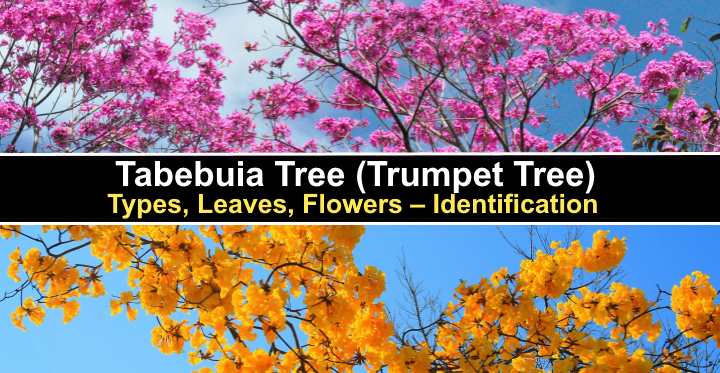
Tabebuia tree, also called the trumpet tree, is a spectacular showy flowering tree with pink, light purple, or bright yellow flowers. Tabebuia trees thrive in hot climates where the deciduous trees add color, strong fragrance, and beauty to garden landscapes. The small to medium-sized trees are easy to grow in full sun as an ornamental tree or shade tree, and they grow well in containers.
In this article, you will learn about identifying the various types of tabebuia trees. Descriptions and pictures of tabebuia tree flowers and leaves will help tell the difference between the species. At the end of the article, you will get some handy tips on caring for a tabebuia tree.
What is a Tabebuia Tree?
A tabebuia tree is a type of small to medium-sized deciduous tree in the genus Tabebuia and family Bignoniaceae. The most common varieties of tabebuia tree grow around 15 to 30 ft. (4.5 – 9 m) tall and 40 ft. (12 m) wide. However, some species can reach heights of 60 ft. (18 m).
Some botanists give the tree the botanical name Handroanthus. However, Tabebuia is still an accepted and well-known name for this tropical tree. The common name trumpet tree refers to the spectacular blooms that appear throughout the summer.
Tabebuia trees thrive in warm, humid climates. The leafy deciduous flowering tree performs best in USDA zones 10 and 11.
The tabebuia tree’s hardiness zone is a reason it is a popular flowering tree in Florida. The tabebuia tree is tolerant of salt and drought and grows well along Florida’s coastal regions. In southern Florida, yellow and pink tabebuia trees are common in residential landscapes and growing as street trees.
The tabebuia tree is identified in the landscape by its open, spreading pyramidal-shaped canopy with sparse branching. The tree’s canopy spread allows dappled sunlight to filter through the foliage while providing shade in the hot summer sun. With age, the crown becomes broader at the top and more irregular.
Depending on the species, tabebuia trees have a moderate to fast growth rate. For example, the pink trumpet tree (Tabebuia impetiginosa) has a growth rate of 12” to 24” (30 – 60 cm) per year. However, a newly planted trumpet tree may take two to three years to bloom and produce flowers.
Common Types of Tabebuia Trees
There are nearly 100 species of tabebuia trees. However, in southern states, such as Florida, four types of tabebuia trees dominate residential landscapes.
Here are brief descriptions of the most common tabebuia trees:
Tabebuia impetiginosa—Also called the purple trumpet tree or ‘Ipe,’ the deciduous tree has showy trumpet-shaped flowers that are rose-pink to purple. The purple tabebuia grows up to 18 ft. (5.4 m) tall and 15 ft. (4.5 m) wide.
Tabebuia heterophylla—The pink trumpet tree thrives in southern Florida. It has pink showy flowers that bloom in spring and summer. The flowering deciduous tree grows 20 to 30 ft. (6 – 9 m) tall and 15 to 25 ft. (4.5 – 7.6 m) wide.
Tabebuia chrysotricha—Called the golden trumpet tree due to its bright yellow flowers, this spectacular flowering tree has a round crown, showy funnel-shaped flowers, and tan-colored bark. The tall, fast-growing tabebuia tree grows up to 35 ft. (10 m) tall and wide.
Tabebuia caraiba—This trumpet tree is also called the silver trumpet tree due to its silvery foliage. The tabebuia tree has showy yellow flowers and palmately compound leaves. Silver tabebuia tree grows 15 – 25 ft. (4.5 – 7.6 m) tall and up to 15 ft. (4.5 m) wide.
Tabebuia Tree Flowers
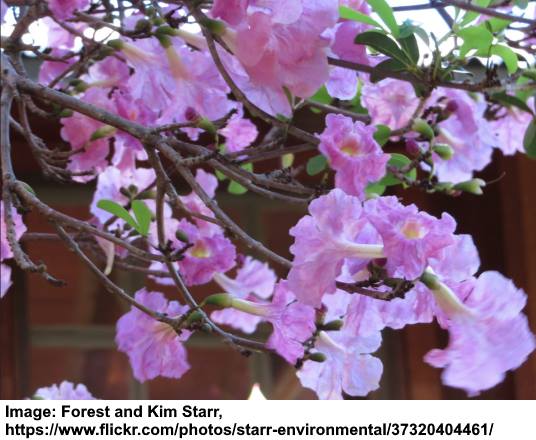
Tabebuia heterophylla flowers
Tabebuia flowers are trumpet-shaped showy blooms that grow in dangling clusters. The colorful flowers can be pink, white, bright yellow, or lavender-purple. The tabebuia tree blooms before the leaves appear in spring. The tabebuia tree has elongated flowers that measure 1” to 4” (2.5 – 10 cm) long.
Tabebuia Tree Leaves
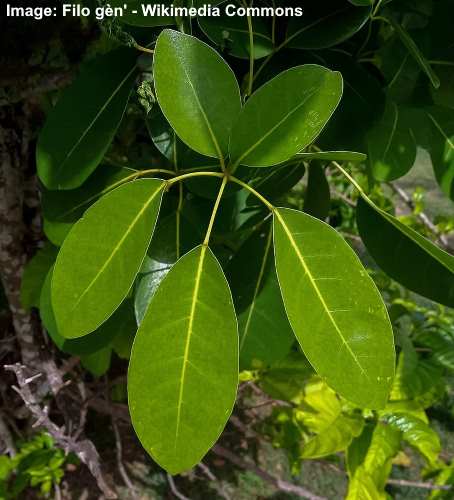
Tabebuia heterophylla leaves
Tabebuia leaves are leathery oval or oblong palmately compound leaves with five to seven leaflets on a leaf stem. Individual leaflets measure 2” to 6” (5 – 15 cm), and the tabebuia whole palmate leaf can measure 6” to 12” (15 – 30 cm) long. Tabebuia tree leaves don’t change color in the fall before they drop.
Tabebuia Tree Identification
To identify a tabebuia tree, look for the distinctive leaves, showy trumpet flowers, and slightly rough, fissured, tan-colored bark. Tabebuia leaves are dark glossy green, made up of five to seven leaflets. The tree’s characteristic showy pink, white or yellow flowers grow abundantly in large clusters. Trees have an identifiable pyramidal crown.
Types of Tabebuia Trees (With Pictures) – Identification
Let’s look in more detail at the most popular types of tabebuia trees commonly grown in southern landscapes and tropical regions.
Tabebuia impetiginosa (Purple Trumpet Tree)
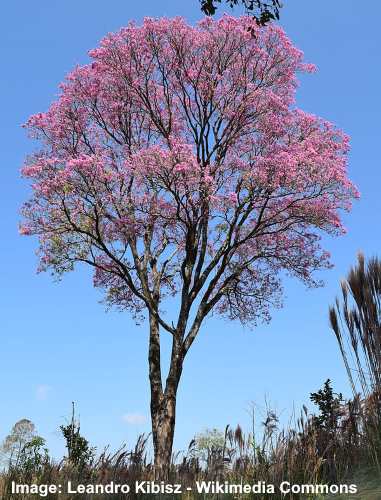
Tabebuia impetiginosa
The tabebuia impetiginosa is a tall flowering tree with spectacular bright pink to magenta trumpet-shaped flowers. The pink trumpet tree has an irregular pyramidal shape with open, spreading branches. The pink tabebuia tree blooms in spring, and its flowers persist through summer. The tree has palmately compound dark olive-green leaves.

Tabebuia impetiginosa leaves and flowers
Tabebuia impetiginosa grows between 30 and 50 ft. (9 – 15 m) tall and spreads up to 40 ft. (12 m) wide. However, in residential landscapes, the slow-growing flowering deciduous tree may mature at 15 to 20 ft. (4.5 – 6 m) tall.
Tabebuia impetiginosa tree leaves consist of five oval to oblong blades that measure 5” (12 cm) long. The leaves are identified by their dark green color, pinnate form, and ovate leaflets with a pointed apex. Typically, flowers appear in late spring when the tree drops its leaves.
After the pink trumpet tree flowers, long brown bean pods develop on the tree. The bean-like pods measure between 3” and 12” (7.5 – 30 cm) long and contain numerous winged seeds.
The bark of Tabebuia impetiginosa tree is brownish grey and smooth when young, and becomes furrowed as the tree matures.

Tabebuia impetiginosa bark
Plant Tabebuia impetiginosa tree in full sun, and moist well-drained soil for best results. Established pink trumpet trees are highly drought-tolerant.
Tabebuia Tree Flowers: The pink trumpet tree’s flowers are showy, bright pink tubular blooms with yellow throats.

Tabebuia impetiginosa flowers
Tabebuia Tree Identification: Tabebuia impetiginosa identification is by its rose-pink or magenta tubular flowers, large dark green palmately compound leaves, and irregular pyramidal shape. Long bean-like seed pods grow in the fall before distributing the small seeds.
Tabebuia chrysotricha (Golden Trumpet Tree With Yellow Flowers)
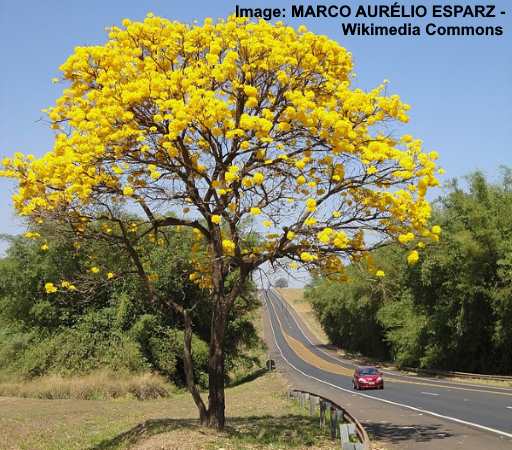
Tabebuia chrysotricha (Golden Trumpet Tree)
The Tabebuia chrysotricha tree is a small semi-deciduous flowering tree with golden yellow, funnel-shaped flowers and long dark green leaves. Golden trumpet trees are identified by their rounded, spreading canopy that provides shade in the Florida sunshine. Tabebuia chrysotricha trees grow between 25 and 35 ft. (7.6 – 10) tall.
Tabebuia chrysotricha tree leaves are pinnately compound with five spoon-shaped or elongated oval leaves with a pointed tip. The individual leaflets have slight serration toward the ends. As the tree matures, the leaf color becomes silvery-green with a brown fuzzy underside.
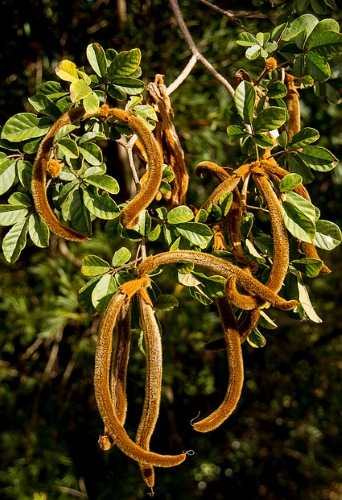
Tabebuia chrysotricha leaves and seed pods
Like most species of trumpet tree, the golden trumpet tree has dazzling floral displays on bare branches. The Tabebuia chrysotricha tree brightens up spring residential landscapes with abundant clusters of funnel-shaped yellow flowers that cover the entire tree.
Tabebuia chrysotricha thrives in USDA zones 10 and 11. The small flowering tree performs best in full sun and moist, well-draining soil. Once established, the yellow trumpet tree is easy to care for in a garden landscape and requires little pruning.
Tabebuia Tree Flowers: The golden trumpet tree flowers are funnel-shaped and bright yellow. The yellow tubular flowers grow at the ends of bare stems.
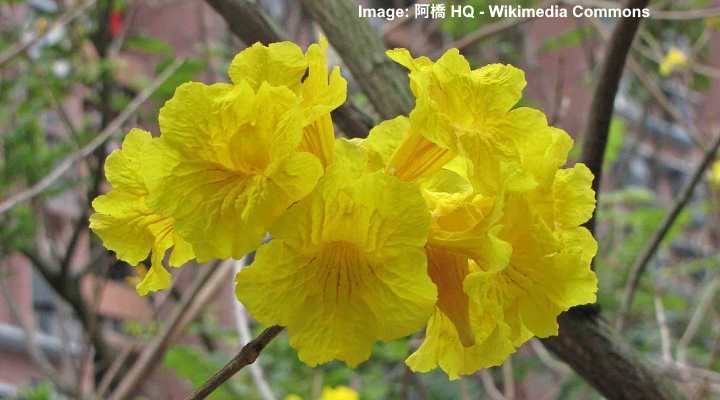
Tabebuia chrysotricha flowers
Tabebuia Tree Identification: Tabebuia chrysotricha tree identification is by its brightly-colored yellow flowers, dark green palmately compound leaves measuring 4” (10 cm), and long brown, hairy seed capsules measuring 8” (20 cm) long. The Tabebuia chrysotricha has characteristic light brown bark that becomes rough and fissured as it matures.

Tabebuia chrysotricha bark
Tabebuia heterophylla (Pink Trumpet Tree)

Tabebuia heterophylla (Pink trumpet tree)
The Tabebuia heterophylla tree is known as the pink trumpet tree for its showy pink tubular flowers that decorate the tree in spring and summer. The spectacular flowering deciduous tree has palmately compound leaves, brown bean-like seed pods, and a pyramidal crown. The Tabebuia heterophylla tree grows 20 to 30 ft. (6 – 9 m) tall.
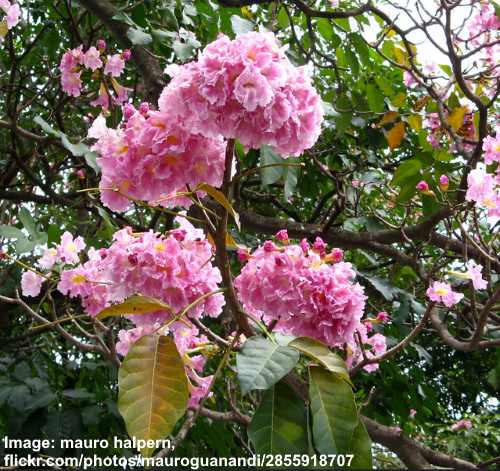
Tabebuia heterophylla flowers and leaves
Tabebuia heterophylla tree leaves consist of five oval leaflets with smooth margins. The individual blades measure 2” to 6” (5 – 15 cm) long, and the compound leaves grow up to 12” (30 cm) in length. Like most species of Tabebuia, the semi-deciduous leaves drop in spring just before the pink or pale purple blooms appear.
After blooming, the pink trumpet tree produces long brown hairy seed pods. These finger-like capsules contain numerous winged seeds. The pods emerge green and turn brown as they dry. Tabebuia heterophylla seed pods measure 3” to 12” (7.5 – 15 cm) long.

Tabebuia heterophylla immature seed pod
The wide, spreading canopy of Tabebuia heterophylla with sparsely growing branches provides dappled shade during the summer. The pink trumpet tree is ideally suited for growing beside a deck or patio to provide shade. The stunning pink flowers and fragrance will add beauty and pleasant aromas to summer gardens.
Tabebuia Tree Flowers: Pink trumpet tree flowers are showy clusters of pinkish-purple tubular blossoms with white sepals and yellow throats.
Tabebuia Tree Identification: Tabebuia heterophylla identification is by its smooth, oval leaves, showy clusters of pink flowers, and silvery gray bark that becomes scaly with age. You can identify the Tabebuia heterophylla by its irregular oval crown.

Tabebuia heterophylla bark
Tabebuia caraiba (Silver Trumpet Tree)
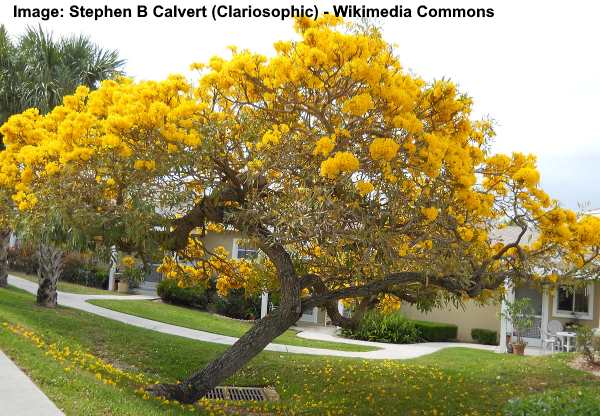
Tabebuia caraiba (Silver trumpet tree), also known as Tabebuia aurea and Tabebuia argentea
The Tabebuia caraiba (also known as Tabebuia aurea and Tabebuia argentea) is a small, multi-stemmed flowering tree with twisting trunks, clusters of golden yellow tubular flowers, and narrow, oblong silvery green leaves. The yellow Tabebuia caraiba flowers measure up to 3” (7.5 cm) long and cover the entire tree after the leaves drop in spring.
Tabebuia caraiba tree leaves are palmately compound consisting of five leaflets measuring 2” to 4” (5 – 10 cm) long. Unlike other species of Tabebuia, the yellow trumpet tree leaves are lanceolate shaped rather than oval and rounded. Also, the lance-shaped leaves grow on the ends of long petioles, giving the foliage a relatively sparse appearance.
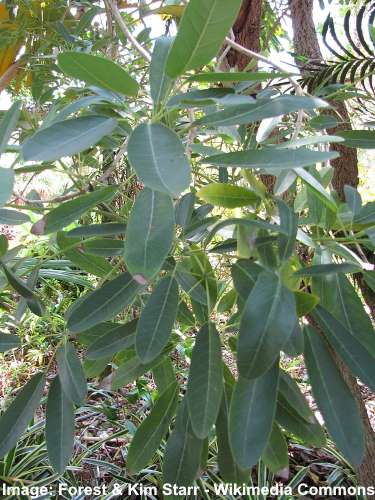
Tabebuia caraiba leaves
Tabebuia Tree Flowers: Yellow trumpet tree flowers are bright golden yellow funnel-like blooms that grow in large, showy clusters at the ends of branches.

Tabebuia caraiba flowers
Tabebuia Tree Identification: Tabebuia caraiba tree identification is by its contorted trunk, clusters of bright yellow flowers, and long lanceolate palmately compound leaves.
How to Plant Tabebuia Tree
Tabebuia trees are easy to grow if you live in warm, humid climates. To plant a trumpet tree, choose the sunniest location in your yard, where it gets around eight hours of sunlight daily. In addition, the ground should be fertile, well-drained.
Dig the hole for planting twice as wide as the bare-rooted tabebuia tree and the same depth as the container. To ensure the soil is fertile and well-draining, amend it with compost, peat moss, and perlite. Plant the young tabebuia tree at the same height as it was growing in the container.
The next step is to backfill the hole, firming down the soil to remove all air gaps. Then, thoroughly water the trumpet tree’s roots. For the first few months, provide deep watering weekly to help the tree get established.
How to Care For Tabebuia Tree
Tabebuia trees are relatively easy to care for in a garden landscape. However, there are a few things to remember to ensure the beautiful flowering tree blooms abundantly every spring and remains pest and disease-free.
Where to Plant Tabebuia Tree
Tabebuia trees thrive in full sun, where they get six to eight hours of sunlight daily. However, the tropical tree will also perform well in partial shade. In cooler climates, you can grow a tabebuia tree in containers during the summer and bring them indoors in the fall.
Tabebuia trees cannot withstand freezing temperatures and are only suitable for USDA zones 10 and 11. However, they may grow well in the warmest regions of zone 9.
Tabebuia Tree Soil Preference
The most important soil requirement for tabebuia trees is good drainage and excellent nutrient content. Trees planted in fertile soil that drains well produce abundant yellow or pink blooms every spring. Soil that drains poorly tends to result in fewer blooms and may affect the tree’s growth.
How to Water Tabebuia Tree
The only time to water a tabebuia tree is if there is an extended dry spell. Established trumpet trees are extremely drought resistant and have minimal watering requirements. It’s good to avoid overwatering a tabebuia tree. Excess moisture affects blooming and can make your tree look sparse in springtime.
As a rule, don’t water the tabebuia tree for six to eight weeks before you expect blooms. This is because tabebuia trees produce more flowers during dry periods. This handy tip helps to ensure a multitude of showy flowers when the flowers drop in the spring.
Tabebuia Tree Fertilization Tips
Fertilize the tabebuia tree every spring until it is established. Yearly fertilizing immature trumpet trees helps establish the root system and encourages healthy, abundant blooming. A suitable tree fertilizer for trumpet trees is 16-4-8. However, established trees don’t require fertilizing.
Remember, it takes a tabebuia tree grown from seed three years to produce flowers.
Pruning Tabebuia Tree
Tabebuia trees require little, if any, pruning. The beautiful ornamental tree has a natural pyramidal crown that gradually fills out as the tree matures. However, during the dormant period, you can prune back branches to maintain the tree’s shape or size. Additionally, removing dead or damaged branches helps to maintain healthy growth.
Propagating Tabebuia Tree
The easiest way to propagate a tabebuia tree is by hardwood cuttings. You need to cut mature shoots 12” (30 cm) long at the beginning of spring. Remove the bark from the lower part of the cutting and put it in a small pot containing potting soil. Water the tabebuia cutting regularly.
After eight weeks, roots should have developed, and you can transplant the rooted tree to your garden or a larger container.
Pest or Disease Problems Affecting Tabebuia Tree
Tabebuia trees are generally resistant to pests and diseases.
One issue with pests could be tabebuia thrips (Holopothrips sp.). The small flying creatures can cause cosmetic leaf damage but are not considered serious pests. The best way to control the thrips is to prune damaged leaves and destroy them.
Related articles:
